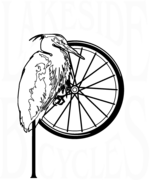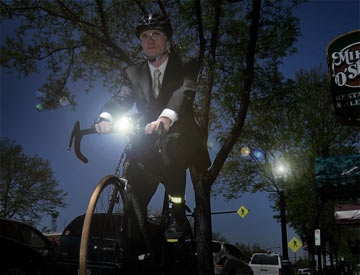 A lot of people buy bicycles never intending to ride after dark and then sometimes find themselves pedaling home after the sun's gone down. This is dangerous because you're almost invisible to drivers and you can't see hazards that could cause a crash. It's also illegal and you could be ticketed should a cop spot you.
A lot of people buy bicycles never intending to ride after dark and then sometimes find themselves pedaling home after the sun's gone down. This is dangerous because you're almost invisible to drivers and you can't see hazards that could cause a crash. It's also illegal and you could be ticketed should a cop spot you.
To avoid these risks we recommend coming in and picking up a basic lighting system comprised of a headlight and taillight. This will set you back only about $30 to $75 (depending on what you select) and offer you the peace of mind of knowing you'll be safe no matter how late you ride. Plus, you'll be prepared should you decide to commute to work when it's dark, or just want to enjoy nighttime rides.
Reflecting on reflectors
You might wonder why you need a light when your bike is already equipped with reflectors. While these are helpful at night, they only light up when lit by a vehicle's headlights.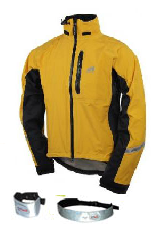 And, they do not light the road at all to help you see. So, for optimum safety, you really need lights.
And, they do not light the road at all to help you see. So, for optimum safety, you really need lights.
It's also good to dress in bright and light colors for night rides. There are now also jackets and vests made of, or featuring, built-in reflective materials that makes you light up in traffic like a reflective street sign.
Another inexpensive safety trick is adding reflective tape to the pedals, crankarms and rims (between the spoke nipples; not on the braking surfaces). This will provide moving reflectors that are more visible to motorists than stationary ones.
Be bright: use lights
While these steps will increase your safety, headlights and taillights are most important for riding at night because they make you visible to cars and also provide light to ride by. The beam of light they cast reveals hazards that could case a crash, such as pavement cracks, grates, potholes, glass and other hard-to-see road users, like a pedestrian in dark clothing.
The basic lights we carry run on standard alkaline batteries available in any store, usually AAs or AAAs. If you prefer, you can substitute compatible rechargeables if you have them. More-expensive lights sometimes come with rechargeable batteries.
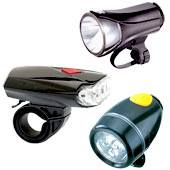 Headlights attache to the handlebars with a small quick-release mount that makes removal easy when the light's not needed. This means the light can also double as a handy flashlight for lighting the walkway to your front door; finding your keys; fixing flat tires; etc. Plus, it makes it easy to move the light to other bikes.
Headlights attache to the handlebars with a small quick-release mount that makes removal easy when the light's not needed. This means the light can also double as a handy flashlight for lighting the walkway to your front door; finding your keys; fixing flat tires; etc. Plus, it makes it easy to move the light to other bikes.
Taillights also have handy features. Most models offer flashing and steady modes and can be mounted to the bicycle or a pack. When mounting it to a pack make sure the light remains visible when you lean forward to ride.
Taillights use LEDs (light-emitting diodes), which are bright enough to be seen by motorists in plenty of time to move over. The LEDs are energy efficient, too, so your batteries will last a long time even if you ride at night a lot.
Interestingly, many headlights today feature LEDs, too. Other common bulb types are halogen and xenon. They all cast a nice beam to illuminate the road ahead.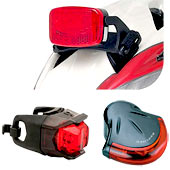
Keep in mind that all of these lights meet the basic safety requirements for riding at night, yet they're best for roads peripherally lit by traffic, buildings and streetlights. If you get into serious night riding where you travel long distances on unlit roads, or especially on trails, you should come in and look at our more advanced lighting options.
A note about generator lights
Another type of basic light is the generator system. Generator lights increase visibility in traffic for safety, provide adequate light for navigation on roads, and don't require batteries, which is their primary selling point. They cost more than basic battery lights since they are more complicated.
These systems, however, aren't as available or popular as they once were for 3 reasons: 1) They usually drag on the wheel (sometimes slipping and cutting out in wet weather). Note that there are also magnet-based generator lights that don't cause drag. 2) They must be bolted to the bike (making them difficult to remove quickly for rides when you don't need lighting). And, 3) They usually turn off when you're not riding, which means at intersections you disappear to motorists unless you also carry a battery-powered bike light.
If you're riding at night, come in and see our wide selection of lights and let us light up your bike!
